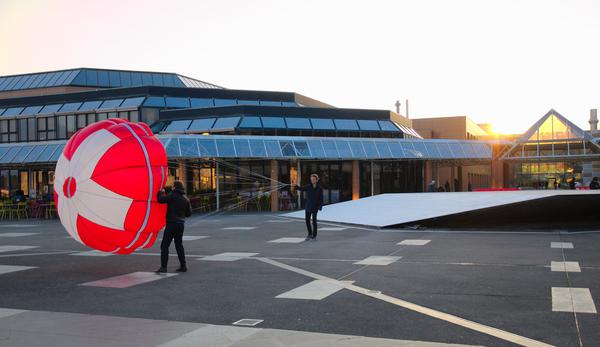An EPFL-designed rocket competes in the United States

Only 18 of the 30 members of the EPFL Rocket Team will be in New Mexico for the Spaceport America Cup. ©Jonathan Burkhard
Students from the EPFL Rocket Team are preparing for takeoff at the Spaceport America Cup. Last year, the team came in eighth out of more than one hundred participants.
After nearly two years of work, “Project Matterhorn,” designed by the thirty students from the EPFL Rocket Team, is ready to compete at the 2018 Spaceport America Cup, which will be held from 19 to 23 June in the New Mexico desert. This competition, which pits teams from universities around the globe against each other, is still not very well known on this side of the Atlantic. This year, only two European teams will take part, one from the Federal Institute of Technology in Zurich (ETHZ) and one from EPFL. Last year, students from these two schools and the School of Business and Engineering Vaud (HEIG-VD) competed together as one team and came in eighth out of the 116 teams taking part.
For the competition, teams have to design, build and launch a rocket that can reach a set altitude as accurately as possible. Teams are also evaluated on the ingenuity of their design and the relevance of their payload – a requirement for every rocket. “We’re entered in the 10k commercial category – the one in which the most teams are competing – with an off-the-shelf engine,” says François Martin-Monier, head of sponsoring and advertising for the EPFL Rocket Team.
A high-tech design
The rocket is 2.70 meters long and weighs over 20 kilos. It has a diameter of just 120 mm, so it’s very compact – which meant the students had to overcome a number of engineering challenges just to fit in all the components needed to make the rocket work. The rocket will be launched using solid propellants for four seconds, and the remainder of the flight will be ballistic. “We chose an engine that will take the rocket up to about 500 meters above the target altitude,” says Martin-Monier, who is studying mechanical engineering. “The onboard computer will then deploy the airbrakes to correct the trajectory in order to get as close to an altitude of 3,000 meters as possible. We’ll have to adapt to the conditions on the day, particularly the temperature, atmospheric pressure and wind.”
For the payload, the EPFL students chose to integrate a muon detector into their rocket. Equipped with its own recovery system, the device was designed to detect enough muons to calculate the speed at which the probe descends. The rocket’s parachute system is also unique: “Most teams use two parachutes, one to slow the rocket’s initial descent and a second one that is released just before the rocket reaches the ground to stop it cold,” explains Martin-Monier. “We’ve brought all that together in one parachute. At an altitude of 250 meters, a rope system will expand the parachute’s surface area.”

More than 70 hours of sewing went into making the different versions of the parachute.©Jonathan Burkhard
Assistance from the experts
Since the project began in October 2016, experts from various parts of EPFL have helped the team, including the physics and mechanical engineering departments, the Space Engineering Center (e-Space) and the Swiss Space Center. “Their support has been very useful – they’ve lent us lab equipment, helped us check our calculations and given us constructive feedback on our ideas,” says Martin-Monier. There were even some Bachelor’s and Master’s semester projects relating to the rocket. More than one hundred credits have been awarded because of the project.
And what about 2019? The EPFL Rocket Team is already working on a new project. Anyone interested in taking part should contact [email protected].
Follow the EPFL Rocket Team throughout the competition by signing up for the newsletter.